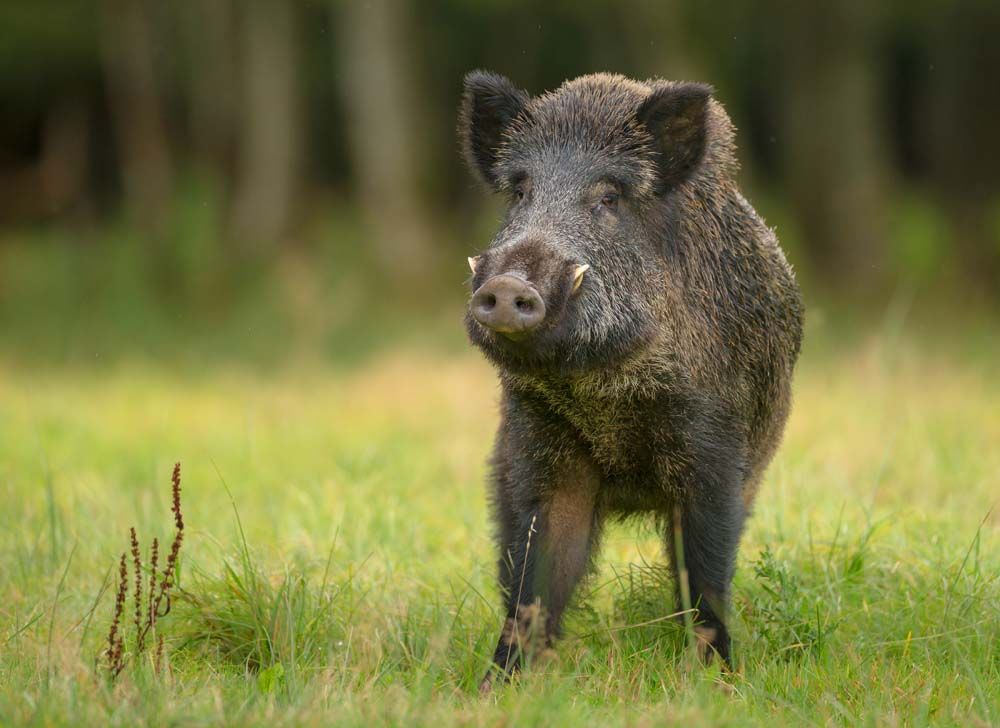Can We Stop the ‘Super Wild Hog’ Invasion?


Growing up on a small farm, we raised some hogs. At times, a growing piglet would slip out of the fence and get busy rooting in the yard. Even a single pig, in a just a few hours, could cause a significant amount of damage. It’s not hard to see how a large population of feral hogs could severely threaten ecosystems.
And they’re here now. And that’s a problem.
Fine food running free
The first pigs were brought to North America during the 1500’s by early Spanish explorers. A hardy food source for explorers, the pigs soon became feral and spread across the southeast, finding the climate and habitat to their liking.
There are many modern stories of wild boars bring brought to the U.S., but one has been clearly documented. During the early 1900’s, Russian type wild pigs were brought to a 1,600-acre fenced-in game preserve in Hooper Bald, North Carolina by Englishman George Moore. A large lodge was built on the grounds and 12 hogs, captured in the Ural Mountains of Russia, were released in the preserve.
A hound hunt, which only resulted in two pig harvests, caused such a frenzy the remaining hogs broke the fence and vanished into the countryside.
And there you have it. Wild pigs have now been reported in 45 states.
Wild hogs aren’t only coming from the south. Russian hogs from Canadian game preserves and farms, brought to the country during the 1980’s, are moving towards the southern border. A crash in the wild hog market in the early 2000’s caused some of the farmers to cut the fences and let the pigs out.
The cold-hardy pigs have no difficulty surviving harsh winters, causing new worries for northern states.
Wild hog problems
Wild hogs cause a variety of problems in the ecosystems they invade. They have few natural predators and an extraordinary reproductive capability. Females breed when they are less than a year old and produce multiple litters of piglets each year.
Wild hogs are voracious omnivores, eating nearly anything they can get their snouts on. They will eat acorns and nuts, small tree seedlings and native plants.
Agricultural crops also are destroyed by the wild hog’s appetite. Corn, grain, oats, rice, along with vegetable crops, are all targets of the invaders. Beyond what they eat, they also can spread disease to livestock, kill calves and lambs, and contaminate feed and pastures.
Hunting doesn’t control the threat
Wild hog hunting fans say it can be a lot of fun. Texans in particular seem to enjoy hunting wild hogs, both for the challenge and for the delicious meat on the table. Wild hog hunting is also big business for ranchers and outfitters, infusing local economies with out-of-state hunters and their money.
Unfortunately, hunting does little to actually stop the spread of wild hogs. Wary animals, when a pig or two is shot out of a herd, the rest scatter and are extremely hard to hunt. The most cost-effective and efficient method to reduce wild hog numbers is trapping.
Single hog traps, such as snares and small live traps, can remove a few of the invasive animals, but the most effective trapping system are those that can capture entire sounders (groups) of pigs.
The Pig Brig Trap was born from a feral hog eradication project in Guam. Fear of encountering unexploded WW II ordnance meant capture nets had to hang from trees instead.
With the bottom of the net above the ground, the biologists discovered that the hog’s natural rooting behavior allowed them to enter the trap unimpeded. A few tweaks and the Pig Brig Trap was born.
Why it works
To start, a ring of T-posts, the size of the net trap, is installed around the baited feeding site. Once the sounder has discovered the feeding site, the nets are hung up. During the conditioning phase, the pigs are allowed to walk under the net, with it grazing their backs. They become comfortable feeding inside the ring.
Once the wild pigs are seen coming with frequency to the trap site, the net is set to trap by lowering it to the skirt to the ground. The net has an opening in the center. The wild pigs root under the net to feast, and once in there, their own body weight prevents them from rooting back out.
Much like a minnow trap, pigs can continue to enter, as the pigs already in the enclosure aren’t agitated. The trap isn’t triggered from afar or loud, allowing the pigs to remain calm.
It truly needs to be seen to be believed—videos at pigbrig.com show the effectiveness and ingenuity of the system.
Captured pigs can be butchered and eaten by the landowner or trapper, donated to local food banks or sold to local markets or processors. USDA inspected processing plants can purchase the hogs and butcher them, selling the meat to restaurants and individuals across the country. Not only are the troublesome animals removed from the landscape, but the delicious meat can be utilized as well. It’s truly a win-win situation for everyone involved!
To learn more
Tags:Features

Acreage Life is part of the Catalyst Communications Network publication family.















